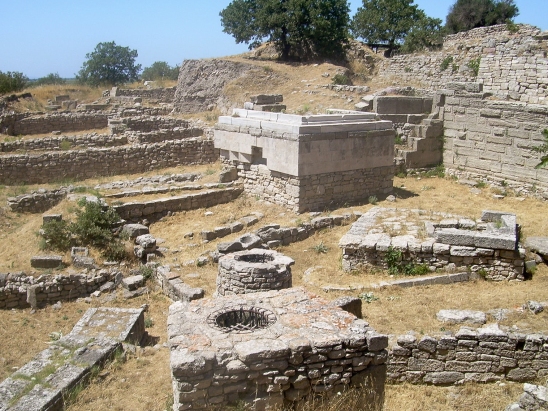 It is the spring of 1873 and beneath the warm Turkish sun workmen labour at a mound of earth and stone. Standing guard over the shimmering blue waters of the Dardanelles, the causeway between Europe and Asia, lie the ruins of not one but nine overlapping cities each built, centuries apart, upon the ruins of the former.
It is the spring of 1873 and beneath the warm Turkish sun workmen labour at a mound of earth and stone. Standing guard over the shimmering blue waters of the Dardanelles, the causeway between Europe and Asia, lie the ruins of not one but nine overlapping cities each built, centuries apart, upon the ruins of the former.
The lead excavator, an eccentric German with too much time and money on his hands, has spent the last two years digging through the centuries in search of a fairy-tale city he is convinced lies buried at the bottom. As the sun reaches its apex and the workers scratch the surface of the penultimate layer, a woman’s voice pierces the air. It is the boss’s wife, a striking Greek lady 30 years her husband’s junior. In honour of Mr Schliemann’s birthday, she informs the team that their work for the day is done.
Confused, but glad to finish early on a full day’s salary, the workers return to their tents. Heinrich and Sofia Schliemann remain. He really turned 61 in January: the shrewd businessman simply does not trust his employees with what he is about to uncover. Submerged three thousand years beneath eight layers of ruin lies what he was searching for all along; the treasures of Ancient Troy.
 Unlike Howard Carter or Arthur Evans, Schliemann was not a trained archaeologist. His father could not afford schooling, so at 14 Schliemann joined an Amsterdam trading firm and started his own at 25. Based out of Saint Petersburg, he worked as an indigo trader, a speculator in the California Gold Rush and a military contractor in the Crimean War. His gift for languages, risky investments and financial knack paid off; Schliemann retired with a fortune at 36.
Unlike Howard Carter or Arthur Evans, Schliemann was not a trained archaeologist. His father could not afford schooling, so at 14 Schliemann joined an Amsterdam trading firm and started his own at 25. Based out of Saint Petersburg, he worked as an indigo trader, a speculator in the California Gold Rush and a military contractor in the Crimean War. His gift for languages, risky investments and financial knack paid off; Schliemann retired with a fortune at 36.
Heinrich Schliemann was socially awkward, secretive and suspicious of everyone around him, preferring the company of books to people. Since a boyhood dream of a burning Troy he was obsessed with the works of Homer, naming his son Agamemnon, and carrying a copy of the Iliad wherever he traveled. Ignoring the wisdom of the time Schliemann believed the cities of Homer were real places; the story of the Trojan War rooted not in a blind bard’s imagination but historical fact.

A typical East Mediterranean tell
The Mediterranean Coast is dotted with giant mounds or tells that mark the ruins of ancient cities. The Iliad placed Troy on Anatolia’s eastern coast, and Schliemann spent years unearthing various tells in the area to no avail. It was not until he met Frank Calvert, a British Archaeologist on a similar quest, that Schliemann began digging at Hisarlik. Richer by far, the German tycoon seized control of the excavation, side-lined Calvert and took full credit for their discoveries.

Sophia Schliemann, wearing the Jewels of Helen
That day in 1873 Schliemann uncovered no less than 8,000 artefacts. Diadems, rings and necklaces of gold and silver, copper cauldrons, goblets, knives and axe heads filled the halls of King Priam.
Most valuable of all were the ‘Jewels of Helen’, an illustrious diadem made of 16,353 gold pieces. Bribing his Turkish supervisor, Schliemann smuggled the treasure to Germany and donated it to the Royal Museum in Berlin. Here it remained until Soviet troops stormed the city in 1945 and spirited the riches away to Moscow.
Taking the broken walls, and charred remains as evidence of Greek invasion, Schliemann proclaimed he had discovered the Troy of Legend.

“I have proved that in a remote antiquity there was in the plain of Troy a large city, destroyed of old by a fearful catastrophe, which had on the hill of Hisarlık only its Acropolis with its temples and a few other large edifices, southerly, and westerly direction on the site of the later Ilium; and that, consequently, this city answers perfectly to the Homeric description of the sacred site of Ilios.”
The Nine Layers of Hisarlik
- Troy IX: 85 BC – 500 AD (Roman,)
- Troy VIII: 700 – 85 BC (Greek, destroyed by Gaius Fimbria)
- Troy VII: 1300-1190 (historical Troy, Late Bronze Age, destroyed by Greek invaders)
- Troy VI: 1800 – 1400 BC (destroyed by earthquake)
- Troy V: 1800 – 1600 BC (fate unknown)
- Troy IV: 2100 – 1950 BC
- Troy III: 2250-2100 BC
- Troy II: 2600 – 2250 BC (Schliemann’s Troy, Early Bronze Age)
- Troy I: 3000– 2600 BC)

He had discovered Ancient Troy, it turned out, but it was not the layer he presumed. Troy II predated the Greek Bronze Age by a thousand years. The Homeric Troy, was most likely Troy VII one of the less impressive ruins Schliemann had decimated in his quest for something greater. What lost civilization had built the second citadel at Hisarlik, or crafted the so called Treasures of King Priam remains a mystery to this day.
Sources:
- Maitland Armstrong Edey, Lost World of the Aegean
- Archaeology.org
